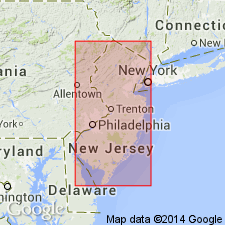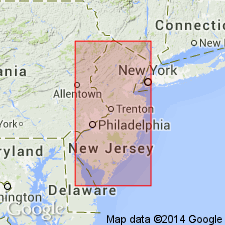
- Usage in publication:
-
- Squankum marl
- Modifications:
-
- Named
- Dominant lithology:
-
- Marl
- Greensand
- AAPG geologic province:
-
- Atlantic Coast basin
Summary:
In a description of Shark River, NJ, author states that the "Eocene greensand known by the name of Squankum marl" consists of 4 ft of hard gray rock underlain by an unknown thickness of loose greensand. Contains few organic remains. Underlies Miocene marl.
Source: GNU records (USGS DDS-6; Reston GNULEX).

- Usage in publication:
-
- Squankum Member
- Modifications:
-
- Biostratigraphic dating
- Reinstated
- Overview
- AAPG geologic province:
-
- Atlantic Coast basin
Summary:
The Shark River Formation, redefined, is expanded to include the Squankum Member (reinstated) and the Toms River Member (new name). The Squankum, previously called the Blue Marl (Cook, 1868), is an argillaceous, glauconite sand. Very coarse sand size glauconite grains, suspended in a cream to gray-brown matrix, are common. An indurated layer, 1 to 3 ft thick, commonly caps the formation in outcrop. The clay content increases with depth, as it grades downward into the underlying Deal Member (new name) of the Manasquan Formation. In the subsurface, grades rapidly upward into the Toms River Member with an increase in quartz sand. Thickness of the Squankum ranges from about 40 ft near outcrop to 20 ft or less in the subsurface. Geographic extent of the Squankum is difficult to determine as pre-Kirkwood erosion has removed the member in many places. The Squankum outcrop, Clark's (1894) type locality of the Shark River, and the exposures along an unnamed tributary to Deal Lake, are the only exposures known to the writer. In the subsurface, the Squankum is present in the USGS Butler Place test well, Toms River Chemical Company well no. 84, Bricktownship Intermediate school well and the Allaire State Park well. The Squankum in the Butler Place well contains the SUBBOTINA FRONTOSA planktonic foraminiferal zone and in the Bricktownship well, the PSEUDOHASTIGERINA SHARKRIVERENSIS zone fauna as well as the basal part of the SUBBOTINA FRONTOSA zone.
Source: GNU records (USGS DDS-6; Reston GNULEX).
For more information, please contact Nancy Stamm, Geologic Names Committee Secretary.
Asterisk (*) indicates published by U.S. Geological Survey authors.
"No current usage" (†) implies that a name has been abandoned or has fallen into disuse. Former usage and, if known, replacement name given in parentheses ( ).
Slash (/) indicates name conflicts with nomenclatural guidelines (CSN, 1933; ACSN, 1961, 1970; NACSN, 1983, 2005, 2021). May be explained within brackets ([ ]).

